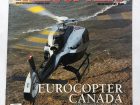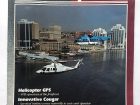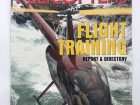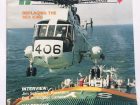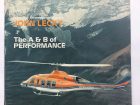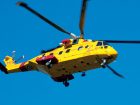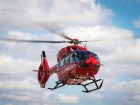
Features
Forty Years of Canadian Helicopters
December 1, 2019 By Jon Robinson
A look back at the development of rotary-wing operations and suppliers in Canada since the founding of HELICOPTERS
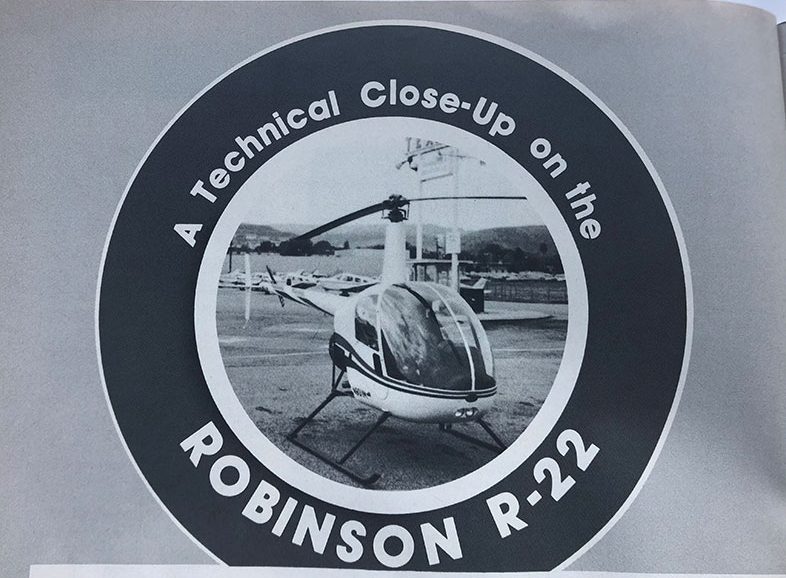 An early report on the game-changing R22
An early report on the game-changing R22 The creation of Helicopters in Canada traces its roots back 40 years when Corvus Publishing recognized the maturity of the domestic helicopter market required content catered to the rotary-wing world. As publishers of WINGS magazine, itself 20 years old at the time, Corvus developed what would become Canada’s first helicopter journal, later renamed HELICOPTERS. Here, we pick up the story of the country’s rotorcraft industry in 1979 with a fitting milestone helicopter delivery to Okanagan Helicopters.
Initially founded as a fixed-wing charter company called Okanagan Air Services, the company purchased a Bell 47-B3 in 1947 and became a driving force behind the rise of commercial helicopter operations in Canada. The company changed its name to Okanagan Helicopters in 1949 and within approximately five years became one of the world’s largest helicopter operators, an incubator of new Canadian rotary-wing companies for decades to come.
1979 – Okanagan Helicopters in March 1979 receives Canada’s first production delivery of a Sikorsky S-76. Founded by three former RCAF officers, Carl Agar, Barney Bent and Alf Stringer, Okanagan is widely regarded as the first commercial helicopter operation in Canada. The S-76 flew as a prototype in 1977 and was certified – with the name Spirit – for IFR flight in February 1979. The twin-engine S-76 was regarded as a third-generation helicopter with a maximum speed of 155 knots and a range above 400 nautical miles. By the summer of 1980, Spirit sales reached 354 with 60 deliveries.
1981 – Ranger Helicopter of Sault Ste. Marie becomes the Canadian distributor of the Robinson R22, holding a list price of $25,000 (not to mention direct operating costs of $1.51 per hour and a fixed operating cost of $6.95 over 500 hours), which the FAA issued a Type Certificate for in 1979. Ranger became involved with the R22 shortly after its first prototype flight in 1975 at Torrance Airport. By the time the first production R22 helicopter was delivered in October 1979, Robinson held an order backlog of 587. The 100th R22 was delivered in 1981 and the 500th in 1985. By 1988, Robinson had become the world’s largest producer of light helicopters, with the 2,000th R22s delivered in 1991.
1982 – SEI Industries Ltd. of Delta, BC, first provided the Bambi Bucket – invented by Don Arney, who founded SEI in 1978 – to the firefighting community in 1982. With a relatively low-cost, plug-n-play capability, this lightweight, strong, flexible firefighting bucket found immediate success and promoted the use of helicopters to fight wildfires. SEI by 2017 was servicing more than 90 per cent of the world’s aerial firefighting water-bucket market, used in more than 115 countries by more than 1,000 helicopter operators. Bambi Buckets are now made in 20 different sizes ranging from the smallest 270-litre bucket to the 9,840-litre version.
1983 – The Department of National Defence in 1983, according to a CASR report, began issuing contracts for the Sea King Replacement Project. Originally purchased to thwart the sudden Cold War development of nuclear-capable submarines, the Sea King entered Canadian Forces service in 1963. With a series of political delays, the Sea King was reassigned in its role and continued to serve in Canada’s military until retirement in December 2018 – as the longest serving aircraft in Canadian military history, with a storied career in international peacekeeping missions and critical domestic services.
1984 – Messerschmitt-Bölkow-Blohm (MBB) Helicopter Canada Limited is founded in Fort Erie, ON, which would eventually become known as Airbus Helicopters Canada. The German aerospace company MBB established its presence in Canada through agreements with Fleet Aviation and both Federal and Provincial governments wanting to establish a more robust domestic rotary-wing manufacturing sector.
1985 – STARS Air Ambulance, initially named Lions Air Ambulance Service by founder Gregory Powell, is established in Alberta and flew its first Calgary-area mission in December 1985. The operation rose to prominence in 1988 as part of the integrated emergency plan for the Calgary Olympic Winter Games. STARS established its second base in Edmonton in 1991 and now also operates 24/7 from bases in Calgary, Grande Prairie, Regina, Saskatoon and Winnipeg. STARS surpassed its 10,000-mission milestone in 2002
1986 – Helijet based in Richmond, BC, launches Canada’s first scheduled helicopter service between Vancouver and Victoria in November 1986. From its early beginnings, with a leased Bell 412 making the 32-minute flight from Lower Mainland to Vancouver Island about eight times a day, Helijet today is regarded as the world’s largest scheduled helicopter airline having carried more than 2.5 million passengers. The company, which was privatized in 2019, now holds operations in Richmond, Vancouver, Victoria, Nanaimo, Prince Rupert and Haida Gwaii, in addition to its Pacific Heliport Services subsidiary, which is Canada’s largest operator of designated heliports.
1986 – Bell Helicopter Textron Canada Ltd. opens its key facility in Mirabel, Québec, which would eventually produce a majority of the parent company’s commercial helicopter lines, such as the 206, 505, 429, 412EPI and 407GXP. By late 2017, the operation celebrated the 5,000th delivery of a helicopter – a 407GXP – to be manufactured in Mirabel. The facility is now known around the world for its expertise in airframe design, product development, flight testing, certification, sub- and final assembly and parts manufacturing in composites.
1987 – Canadian Holding Corporation (CHC) is created largely under the direction of Craig Dobbin, who started Sealand Helicopters in Newfoundland back in 1976. Sealand in 1987 was combined with Toronto Helicopters and the 40-year-old pioneering brand of Okanagan Helicopters. By 1995, with the purchase of British International Helicopters one year earlier, CHC revenues exceeded $1 billion. Before the end of the decade, CHC would acquire Norway’s Helikopter Services Group and Australia’s Lloyd Helicopters.
1991 – VIH Logging Ltd. is founded by Ken Norie, who is instrumental in obtaining the Canadian certification of Kamov KA32 helicopters for use in heli-logging. Norie had joined VIH Helicopters as a pilot in 1973 and subsequently served in base, marketing and operations management roles until founding VIH Logging. In 1999, Norie became the sole owner of VIH Helicopters, which consolidated and rebranded as VIH Aviation Group Ltd.
1992 – The R44 helicopter receives FAA certification. With a base price of US$235,000, the first production R44 Astro is delivered in 1993. The 1000th R44 helicopter was delivered by the start of 2001, just after the 4,000th Robinson helicopter was received by a customer, including more than 3,100 R22s. The 3,000th R44 was delivered by 2006.
1993 – Panalpina, the Swiss logistics and freight forwarding company, establishes Heliship in Vancouver, BC. The operation was created after Panalpina in October 1993 transported three Bell 205 helicopters from Abbotsford, BC, to Rancagua, Chile. Heliship has since shipped thousands of helicopters around the world.
1994 – West Coast Helicopters is co-founded in Port McNeill, BC, by Peter Barratt. Today, the operation is a fully certified Robinson service centre and an industrial paint shop. With a fleet of Airbus AStars, Bell Jet Rangers, and a McDonnell Douglas 500D, West Coast today has four hangars located on Vancouver Island and the mid coast, including bases in Port McNeil, Bella Coola, Campbell River and Nanaimo.
1995 – DART Aerospace, founded in 1975, made its manufacturing debut of a Helicopter STC in 1993 for landing gear and in 1995 stamped its position as a worldwide leader in the development of flotation devices. With a line-up of more than 700 STCs and 5,000 helicopter products, DART offers a comprehensive portfolio of aftermarket products and accessories to the worldwide market. The company moved its manufacturing to Port Hawkesbury, ON, in 1998.
1997 – Canada in 1997 receives delivery of its final CH-146 Griffon, which first entered service in 1995 after a massive commitment to purchase 100 such aircraft built by Bell Helicopter. Occasionally criticized for its lack of power in certain conflicts zones, the Department of Defence points to its multi-role capabilities to provide aerial firepower, reconnaissance, search and rescue, and aero-mobility. In early 2019, the Canadian Forces set out objectives to extend the life of what is now a fleet of 85 Griffons to at least 2031.
1998 – The Sikorsky S-92, a twin-engine medium-lift helicopter, makes its first flight with its introduction to come in 2004. The CH-148 Cyclone is the shipboard maritime helicopter variant of the S-92 earmarked for the Canadian Forces to eventually replace the Sea King in 2018.
2000 – Canadian Helicopters is formed in the year 2000 through a management buyout after CHC moves to divest itself of certain Canadian assets. In 2005, Canadian Helicopters became a public company and CHC divested all of its equity interest. After going private 2017, Canadian Helicopters is now one of the country’s largest helicopter transport companies with more than 110 aircraft. In addition to its flight school growth, Canadian Helicopters also developed its MRO interests, which included purchasing 49 per cent of airframe repair operation Heli-Welders Canada (Langley, BC) in 2009 – with ownership increasing to 80 per cent by 2010. In 2011, Canadian Helicopters Group purchased Helicopters New Zealand for NZ$154 million and in 2012 changed the name of the combined company to HNZ Group.
2002 – The CH-149 Cormorant performs its first mission for Canadian Forces, after its first flight in 2000. The Canadian government committed to add 15 helicopters from the AgustaWestland AW101 platform, which is now controlled by Leonardo after its 2016 merger with AgustaWestland. In 2019, Canada announces plans to purchase at least two more Cormorant search-and-rescue helicopters and upgrade the remaining 14 helicopters in the fleet to meet operational availability requirements to support domestic SAR service to 2042 and beyond. The Cormorant Mid-Life Upgrade project is valued at up to $1.39 billion, with Leonardo serving as the CH-149 Cormorant’s OEM and IMP Aerospace as the in-service support contractor.
2003 – Safran Helicopter Engines Canada is established in Mirabel, Quebec, to support Arriel and Arrius engines across North America, while also providing a range of MRO engine and module services. More than 600 of the facility’s engines fly in Canada. It also supports more than 160 operators. Since 2007, this Canadian operation has held the worldwide mandate for the purchasing and distribution of tooling for its turbines’ after-sales service. In 2013, the Arrius 2R was selected to power the new Bell 505 Jet Ranger X, which would be built nearby. It was the first Bell product to be powered by a Safran engine.
2003 – Cougar Helicopters becomes part of the VIH Aviation Group. Cougar was founded 1984 by Ingo Strackenjan and Earl MacFarland to provide shuttle service from St. John’s International Airport to downtown. The company would become a key player in the growing Newfoundland and Labrador – and global – offshore market and by 2012 develop a dedicated SAR facility in St. John’s, which is now leveraged by Canada to improve response times.
2004 – Heli-One is established in Richmond, BC, as a separate business under parent company CHC to focus on third-party work. Today, Heli-One has MRO operations in Richmond and Delta, BC; Stavanger, Norway; and Rzeszow, Poland.
2005 – The Ontario government contracts a not-for-profit corporation called Ontario Air Ambulance Corporation to manage its air ambulance operations. The corporation’s name in 2007 was changed to Ornge Air. Now operating out of 12 bases across Ontario, Ornge owns a fleet of eight Pilatus NG PC-12 airplanes and 11 Leonardo AW139 helicopters, as well as 13 Crestline land ambulances. To put its aviation demands into perspective, Ornge serves more than 13 million people over one million square kilometres of land, which is equivalent to the size of France, Spain and the Netherlands combined. The operation now performs approximately 20,000 patient-related transports per year.
2010 – This year marks the entrance of the 600th Eurocopter Helicopter into the Canadian market. Renamed Eurocopter Canada back in 1992, Airbus Helicopters’ portfolio in the country expanded as a result of a merger between the rotorcraft divisions of AS350-giant Aerospatiale (France) and Deutsche Aerospace (Germany) to create the Eurocopter Group. A year earlier, the operation reported having greater than 50 per cent market share in Canada in terms of new aircraft deliveries over the past decade.
2011 – Pratt & Whitney Canada’s PW200 turboshaft engine fleet by the end of 2011 reached its 5 millionth flight hour, confirming the engine series’ leadership position in the global light-twin helicopter market. Introduced in the 1990s to address multi-role rotorcraft, the PW200 powers aircraft like the H135, AW109E Power, AW109 Grand, Bell 427 and 429, Kazan Ansat and MD Explorer 900 series. Competing in the 500- to 800-shp class, the engine series leverages the experience of P&WC’s legendary PT6 engine family to offer operators unprecedented levels of reliability and economy. The PW200’s modular design – with only three major rotating components – makes it one of the simplest turboshaft engines in its class, while introducing electronic control, advanced materials and coatings, and a one-engine inoperative pilot training feature. By 2016, there are approximately 3,500 PW200 engines flying in 80 countries.
2012 – Transport Canada issues a Type Certificate for the Robinson R66, with almost 400 such aircraft already operating worldwide. Robinson Helicopter in 2019 announced the R66 Turbine fleet, powered by the Rolls-Royce RR300 engine, had surpassed one million flight hours without a reported in-flight engine failure.
2013 – Universal Helicopters Newfoundland Ltd. in 2013 entered into an agreement to sell its operations to a limited partnership formed by Nunatsiavut Group of Companies, Tasiujatsoak Trust and CAPE Fund. Maintaining a version of the Universal Helicopters name, the operation is a majority-owned Inuit company and was one of the first operators in the world to incorporate the Bell 407. In 2018, it purchased Lakelse Air of Terrace, BC, to become Canada’s only coast-to-coast Indigenous-owned helicopter services company.
2014 – Eurocopter rebrands as Airbus Helicopters as its Canadian operation turns 30 years old. By its 35th year in Canada, in 2019, Airbus is supporting approximately 200 customers operating more than 700 aircraft in the country. Airbus Helicopters Canada is known internationally for the manufacture of composite parts for approximately seven helicopter models. This key segment runs in a dedicated 50,000-square-foot space within its 138,000-square-foot Fort Erie, ON, facility. The operation now employs more than 240 people.
2016 – On the last day of 2015, AgustaWestland merges into Leonardo to form the Italian company’s helicopter division. Leonardo has been active in Canada for approximately 50 years – today, holding around 400 employees at five operating sites. At the start of 2015, Leonardo had some 90 civil and military helicopter variants operating in Canada – in addition to close to 5,000 in operation around the world. This included prominent AW139 deployments with the likes of STARS and Ornge, as well as the Canadian Forces’ CH-149 Cormorant. In 2019, Leonardo Canada was established in Ottawa to prepare for the new Canadian Defence Investment plan.
2016 – Vector Aerospace generates revenues of approximately $930 million in 2016, employing around 2,200 people in 22 locations. Purchased by Airbus (via Eurocopter) in 2011, Vector was established in 1998 when CHC consolidated its MRO assets and sold 80 per cent of the entity through an IPO offering out of Toronto – before divesting itself of the asset completely by the following year. In 2017, StandardAero completed the purchase of Vector in large part to extend its reach into the helicopter MRO market with the M250, PT6T, and Arriel 1 and 2, among other engines. This boosted work for StandardAero’s key facility in Winnipeg, where the company was founded in 1937 – with roots tracing back to 1911 as Standard Machine Works. The Carlyle Group in April 2019 purchased StandardAero, which at the time had 6,000 employees at 38 primary locations.
2017 – The Bell 505 Jet Ranger X begins production in Mirabel, QC. By 2019, the Bell 505 Jet Ranger X fleet would surpass more than 20,000 flight hours just weeks after the delivery of the 200th 505 Jet Ranger X to Austria-based operator Hubi-fly Helikopter GmbH. The first delivery of the Bell 505 occurred in March 2017 to Pylon Aviation and today the global fleet is flying across six continents. The company describes the 505 as one of the fastest-growing current commercial models to accumulate flight hours.
2018 – The Sikorsky CH-148 Cyclone is introduced into the Canadian Forces in July 2018 as a twin-engine, maritime helicopter. A military variant of the Lockheed Martin Sikorsky S-92, the CH-148 is designed for shipboard operations to replace the CH-124 Sea King, in operation from 1963 to 2018.
2019 – STARS Air Ambulance in mid-2019 takes delivery of its first two Airbus H145 aircraft as part of a plan to replace its entire fleet in Western Canada. STARS in June 2018 unveiled a multi-year map to renew its fleet of BK117 and AW139 helicopters with nine Airbus H145 aircraft, holding an estimated cost of $13 million each, medically equipped. STARS’ fleet renewal program initially received financial support from both Federal and Alberta governments. The most-recent Federal budget unveiled in March 2019 earmarked $65 million for the program, which also relies on funding campaigns.
